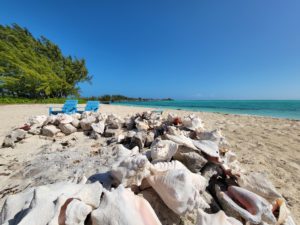
That’s Fly Fishing Fun Bahamian Style
Last year my scheduled trip to the Bahamas was cancelled when the country closed it’s doors and borders due to the spreading Covid-19 Virus. While I was disappointed by having to cancel the trip, I understood the restrictions and knew it was for my own safety and as well as the safety of others.
Now that the US and neighboring countries are close to herd immunity, and vaccines are being distributed, new cases have drastically slowed and the world is getting back to business. The Bahamian government finally reopened it’s doors to international travelers with the hopes of stimulating the economy. Flights to and from the Bahamas are running again, but they’re limited. Flights to the smaller island even more so. Cautions and safety measures are in place with additional requirements for travel and health documentation required, including:
- A negative Covid test within 72hrs of boarding the plane
- An approved Health Visa Form from the Bahamian government
- Filling out a daily Bahamian Health Survey during your stay
- A Negative Covid Test on the 5th Day of stay
- A Negative Covid Test within 72hrs of boarding a flight to re-enter the US
While it sounds like a lot, it’s all pretty simple and easy to comply with. I flew from Denver to Ft. Lauderdale on United Airlines then took Makers Air from Ft. Lauderdale to the Congo Town Airport on South Andros Island. The trip was easy and I did notice a lot more people flying. Airports were much busier than they have been over the past year.
The drive from the airport to Andros South Bone Lodge took about 20 minutes on a paved but single lane road passing homes, local businesses, churches and schools.
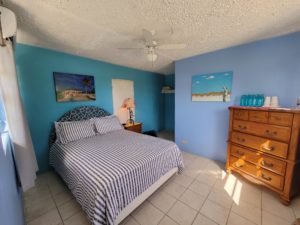
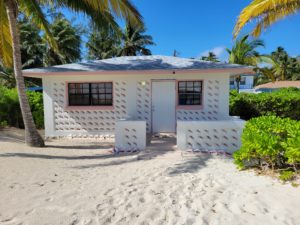
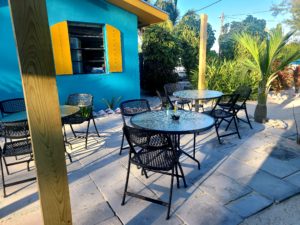
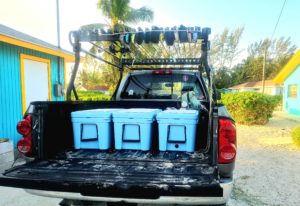
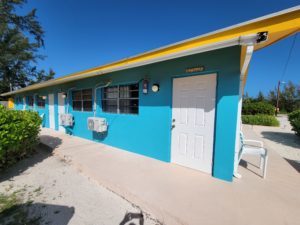
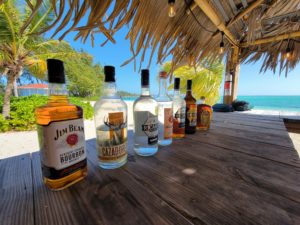
Andros South Lodge is relaxed, informal, and has a cheery Bahamian vibe. It’s exactly what I think of when I recall my time spent years ago in the Bahamas, with my dad. Staff was friendly and accommodating, and the self-serve refreshments and bar made it easy to feel at home.
There was constant entertainment from the several Royal Potcake pups (a Bahamian mutt), that called Andros South Lodge their home until they’d be adopted. They were cute, well behaved and if I didn’t already have 4 dogs of my own at home, these guys might have been traveling back to Colorado with me.

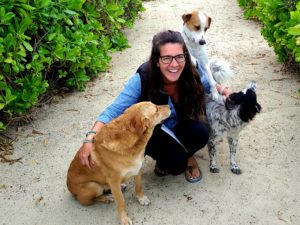
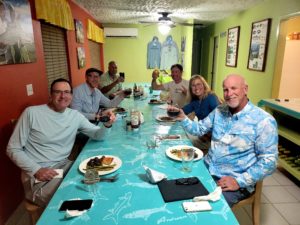

Breakfast and dinner were served in a cozy single room dinning area and lunch of course was packed each day to be enjoyed on the water while fishing. The food was uncomplicated but delicious with a dash of local flair and seasonings to keep it tasty and authentic.
The first day I arrived was not a scheduled fishing day so the afternoon and evening was open to do some DIY fishing from the lodge, swim, explore and rest up. After lunch I headed for the beach and sandbar to look for fish and warm up my casting arm. The tide was coming in and a little deeper than I would have preferred. I still managed to hook several jacks, snappers and a couple of really nice bonefish. It was the perfect opportunity to practice my strip-sets which aren’t as embedded into my muscle memory as my trout sets. Many a bonefish have been lost to anglers who trout set, simply out of habit. Those are always sad moments on the flats.
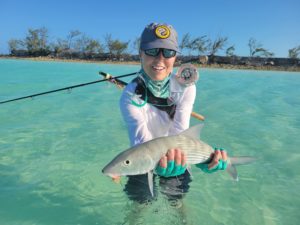
For the next seven days, coffee would start at 5:30am, breakfast at 6:30am and the truck ride to the boat dock 5 minutes away, ready to go at 7:30am. All rods and gear were loaded for me and the guides ready and waiting. After a quick introduction, we were off. Most boat rides were about 30 minutes, some as long as an hour and others about 15 minutes. It all depended on the weather, the water and of course, the fish.
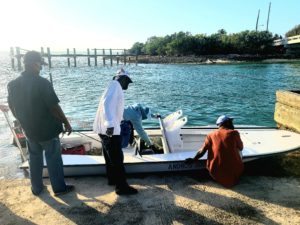
My gear consisted of a Zen Kyojin II 12ft Spey Tenkara Rod, setup with a 28ft Zen Fusion Tenkara Line and 12ft of 16lb test leader. I also brought my 9ft Winston Boron Plus III 8wt with a Hatch 7 Plus Finatic Reel, and another rod specifically dedicated just for barracudas – my 9ft Winston Air Salt 10wt with a Baur RX6 Reel complete with a wire bite guard and a huge deceiver fly or Cudda fly. This rod was always ready to be cast on the boat and whenever we walk-waded, the guide carried it.
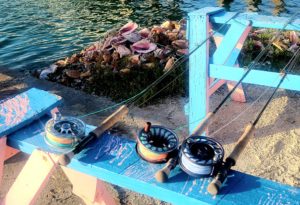
Our goal was to scout and hunt for larger bones and not spend the day casting into big shoals. Instead of going for numbers, I was more interested in going for size. I really wanted to push the limits of the Kyojin rod as well as the tenkara fixed-line method, and see if I could be successful with the big bones South Andros is famous for. I ‘d already landed tons and tons of bonefish in the 2-5lb range in Mexico and the Seychelles. Now I was after something bigger – quality verses quantity as they say.
I equate sight fishing in this manner to hunting, and I prefer it over blind casting into schools. School fishing is fantastic for anglers new to salt or new to bonefishing. When you cast into schools, you get tons of opportunities to practice casting, strip-setting and landing fish – tons of fish, which makes you better. Sight casting to a specific fish is predatory; you find your target, you have only one – maybe two shots, your presentation has to be perfect, and if you can put it all together into one magical moment, the rewards are spectacular. Now, take away the reel and commit to one fixed length of line, well, the challenge is off the charts but so are the rewards! You can’t be scared of losing a fish when using tenkara in the salt. Some situations are perfect, but others are much more challenging. When sight fishing for big bones on tenkara, there will be fewer fish (there always are when casting to singles or doubles rather than schools) and fewer opportunities (since some you just won’t be able to reach), but greater thrills and greater feelings of satisfaction. Sometimes it’s easy, sometimes it’s really, really hard but that challenge is what makes it so awesome.
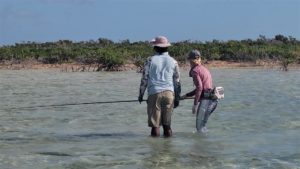
During this trip Mother Nature was being a little fickle. Cloud cover was a daily issue. We’d have 3-5 minutes of bright sunlight, then 3-5 minutes of dark cloud cover. That was the rhythm of our days. I think the artic blast that was impacting the majority of the United States at the time, was responsible for some of the weather patterns we were experiencing.
Wading, which I prefer, especially on tenkara, was a tough nut to crack due to low light conditions. When you’re wading and have cloud coverage, you can’t see very well due to the lower vantage point. Each time the clouds block the sun, you have to stop walking and quietly stand still, incase there’s a bonefish just in front of you that you can’t see. Visibility on the boat, with the higher vantage point, was still tough in the low light, but it was much easier than in the water. Add to that, a constant 15-20mph wind that disrupted the water surface, and I felt as blind as a bat. Luckily, my wonderful guides still spotted fish and directed me to them. Their ability to see fish is mind blowing.
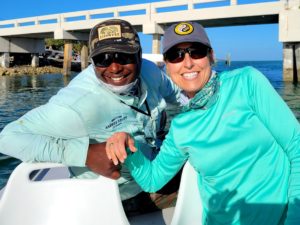
All the Bahamian guides at Andros South Lodge were super excited about this “different kind of rod with no reel”. They listened as I explained and showed them how to attach the line. When we went over the play and landing, they got really excited. “Yeah, yeah, I get it, I understand. I want to see this. I want to see this in action man,” said several guides. They quickly understood that for these bigger bones, being in the water would be better.
So wind and light can always be an issue but there was also the bottom challenge. Much of the flats area where we were fishing was a combination of coral, sand and mud. In many places, wading was just impossible. If you did get out, you’d walk a step or two then sink up to your knees in fine, silty mud and have to work hard to pull your foot out. That isn’t ideal for managing bonefish on a tenkara rod or any rod for that matter, and that remained the bigger challenge for the entire trip; finding fish in a location that had a packed bottom that could be successfully waded. The guides knew where to find packed bottoms, and they knew where to find fish, they just weren’t always in the same place at the same time. When we did encounter those places, would the weather cooperate? Would we be able to see the fish while wading? Easy is overrated.
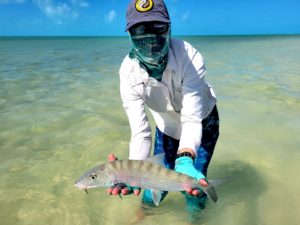
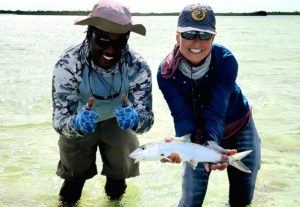
The problem with landing big bones 5lbs and up on a tenkara rod from a boat, is that you need to be able to move. The boat deck isn’t big enough to take 4 or 5 big steps to catch up to the fish when he runs, and stay in the power curve. When a fish that size attempts to run, you have an instant to respond, maneuver and keep the rod from straightening out because if that happens, game over. We poled the flats and I cast and landed a bunch of fish using my reel setup until we got to places where the guide thought we’d have good wading.
One day we waded a sweet flat with a packed bottom. My guide situated me between two feeding shoals. We targeted bones that were on the peripheral edges and were moving freely in and out between them. I had shots at several doubles and wolf packs of 3 to 5 fish, usually moving very fast before regrouping. It was perfect for the fixed-line tenkara setup and we had an awesome time. The thrill and rush was immense. My guide laughed and smiled and had a blast. “That’s AWESOME man, just awesome”!
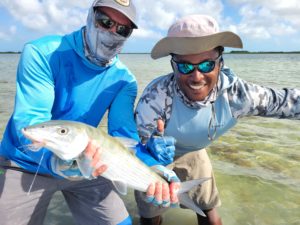
If we were “bubbling” (covering water by poling in the boat), I mostly used my rod and reel. Some of the fish we spotted were massive – easily 10lbs, and I knew I would be risking the rod to try to play and land a 10lb bonefish from the deck of the flats boat. One additional “issue” we faced while fishing tenkara was the sharks. I hadn’t planned on that. I’ve fished in a number of places where sharks cruised the flats: The Maldives Islands, The Seychelle Islands, the Florida Keys and to a lesser degree, Mexico. In Costa Rica crocodiles were a possible issue, depending on where you were fishing. On this trip to South Andros we saw about 100 sharks over the course of 7 days . I also lost several hooked fish to sharks that attacked while on the line. The sharks were an average of 3-5ft.
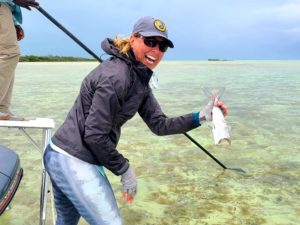
Sharks feed on bonefish. They follow the shoals on the flats. Generally, bonefish can out-run sharks because sharks are fast in short spurts but bonefish can run longer. Sharks often cruise the shorelines looking for unhealthy or injured bones. They’re also attracted to splashing that mimics a fish in distress. When sharks are feeding and frenzied, they bite what they bump. I wasn’t worried about intentional attacks by a shark. I was more concerned that I’d have a bone on the line, a shark chasing it, and during the frenzy, the shark would accidentally bump into me and instinctively bite.
When fishing on a regular setup and this happens, if you can’t land the fish quickly then you need to release all the drag on your reel and let the bone run. It doesn’t always work as I saw for myself this trip, and I wasn’t thrilled about splashing through the water during a chaotic landing or get-a-way attempt by a hooked bone. Maybe I’m a whimp, but I did reconsider getting into the water to fish tenkara on a few occasions simply due to the number of sharks in the immediate area. Crazy, right?
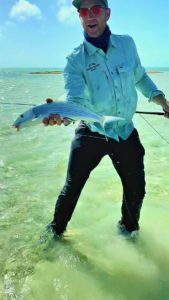
While we were at the lodge, there were a few other guests there too. One gentleman, Bucky, CEO of the Fly Fishing Collaborative, was really curious about tenkara and asked if I’d give him a mini lesson and he could try it the follow day. Of course I would. That morning he took off with his fishing buddy in one direction and I took off in another. As we pulled away from the dock, I figured my rod would come back broken at the end of the day, if it came back at all. That evening as we gathered on the porch for evening cocktails, Bucky arrived with a huge grin on his face. Before I could even ask, he started to tell me what great fun it was, and that he landed several bones on the rod. “What an adrenaline rush, it’s so much fun”! When I asked if the rod held up (attributing a break to him being a beginner), he said it was fine – he had no problems and hooked many! His trip ended with him and his fishing partner each leaving the lodge with a tenkara rod. They just had so much fun.
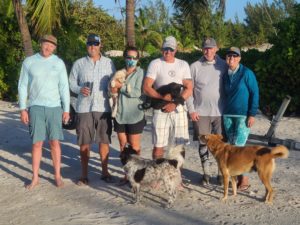
Bahamian bones on tenkara – can it be done? Yes it can. Is it the most effective way to fish for them? No, it isn’t. But it adds spice and excitement to the game, adds an exciting challenge, and gives you a rush that you just can’t explain until you’ve actually done it. Ask Bucky about that. It’s a great addition to experiment with at the end of a successful salt trip that’s primarily designed for a reel.
Andros South Bone Lodge on South Andros Island in The Bahamas is an incredible fishery. You have so many shots at so many fish, even when the weather is less cooperative. All the guides were truly curious and interested to learn about tenkara and totally got it. They understood what I needed to be successful on a fixed line and they made it happen, having a blast the entire time too. Every day they worked hard to not only find fish and spot them, even in really low light, but also find them in areas that were conducive to tenkara.
Once you’ve landed a ton of bonefish on your reel, consider trying something a little different. Embrace the challenge. You end up with a fantastical story to tell your friends, one they won’t believe except for the fact that it actually happened, and you were the one who did it. Andros South Bone Lodge, has Zen Tenkara Kyojin Rods. They know how and where to use them. They’re the only lodge in the Bahamas that can help you land a bonefish on a fixed-line tenkara rod. So take it up a notch, add some more excited to your saltwater fly fishing. Come home with real story and an awesome experience.

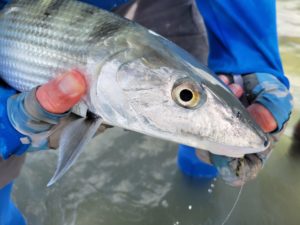
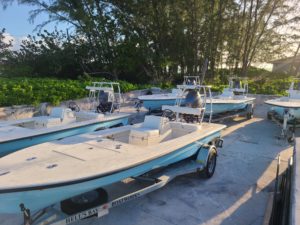
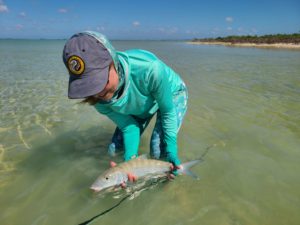


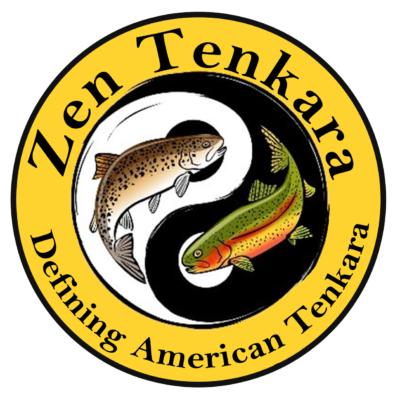

OMG, such a fun read but I bet it was so much better being there and doing it! I love the excitement you gave the guides and other guests in teaching your methods because you make it look so easy! Even I want to try it now!
So glad you had a wonderful trip after waiting for a year. I hope there are more stories to come from more adventures!
Jeannie it was great fun and I just love meeting people from all over. That’s one of the joys I didn’t mention – when you’re done fishing for the day, you go back to the lodge and share stories and excitement with great people who share your love of the sport. And it just so happens, fish live in really beautiful places. Thanks for taking the time to read the article and comment 🙂
Hi Karin,
That sounds like great fun!
I am curious about your tenkara equipment for this fishing. You mention your Kyojin II. Did you use the Taka or any other rods during this trip?
Can you share the reasons for your selection?
Also, you mention the Zen Fusion Tenkara line – please tell me more about this line.
Thanks for bringing tenkara to the salt!
All great questions! I brought both the Taka and Kyojin on this trip (as well as an 8wt and a 10wt regular rod and reel). I really enjoy casting the Taka for its elegance and it can handle very strong fish but the delicate, flexible tip can often make casting in very high winds difficult – particularly when carrying an approximate 40ft setup and possibly a heavier fly. In conditions like these, those top sections of the rod start to get pushed over from the wind. It makes casting and lifting that much line tough. This is where the Kyojin shines. Its “stiff” for this very reason. It allows you to lift 40ft+ of line almost instantly and place it out there accurately. When you are dealing with 15-25mph winds this is critical… and with that amount of line an absolute necessity. IN that much wind there is not back casting – its spey type of movements and rolls. A soft rod just folds in that wind. During this trip the Taka stayed in the room and never made it out of it’s rod sock. This was not my easiest tenkara trip. If the weather had been a bit more cooperative, offering up better light, we would have had more shots while wading and gotten into more fish. But that’s fishing for you. Mother Nature rarely reads here emails.
The new Zen Fusion Lines are very exciting. We’ve been working on them for several years now. Originally we were going to produce them overseas, but (happy dance)we approached RIO and they not only liked our idea, prototypes and the concept, but they were willing to produce them for us! So, now they’re not only being made in the USA, but by a big guy like RIO. Two of these lines are designed specially for the KYOJIN. They’ll work on other brand rods too, but its a big boy line, tapered at both ends and able to connect in either direction for a different presentation. We are producing them in 2 length. The other lines will be level and floating, designed to be laid on the water and fished more like a regular fly line – but with a tenkara rod, thus a “fusion” of both methods. They are super easy to cast, easy to manage and easy to store and care for. We are behind in due to production set backs y tuned from Covid. We are hoping they will be complete by end of May or early June. RIO has had to get caught up too so everyone is getting back up to speed slowly and getting caught up on backlogged. So stay tuned. Cool things are coming.
Pingback: Creating Magic through Fishing Memories - Zen Tenkara